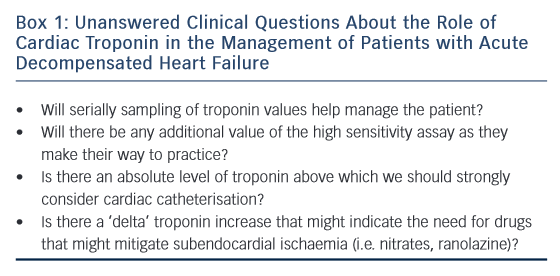Clinical Relevance
There is no question that an elevated troponin level is prognostic in AHF, and that the higher the level, the worse the prognosis. It is important to remember that cTn is a marker of myocardial necrosis and primarily used to diagnose ACS, which could be the cause of an AHF event. In this role, the percent change in the troponin value on serial  measurements and the absolute peak value provide important diagnostic and prognostic information.47,48 Not only is it critical to measure cTn levels to assess for ACS, but the value also provides significant prognostic information for mortality as well as readmission risks and has correlated with other various endpoints. Although finding an elevated cTn helps the clinician risk stratify a patient for outcomes, it does not necessarily help guide immediate therapy. Unanswered questions are depicted in Box 1.
measurements and the absolute peak value provide important diagnostic and prognostic information.47,48 Not only is it critical to measure cTn levels to assess for ACS, but the value also provides significant prognostic information for mortality as well as readmission risks and has correlated with other various endpoints. Although finding an elevated cTn helps the clinician risk stratify a patient for outcomes, it does not necessarily help guide immediate therapy. Unanswered questions are depicted in Box 1.
Outside of an ACS event, which can be treated with revascularisation, it is unknown what measures, if any, can be taken to lower an elevated cTn level and decrease the risks of mortality and readmission. Thus an elevated cTn level is limited in its ability to create an actionable trigger for therapy such as increasing neurohormonal blockade, adding antianginals such as nitrates or ranolazine, or increasing diuresis. However, in its ability to help predict prognosis alone and in models, it can help the clinician inform the patient of prognosis as well as consider whether referral to an advanced heart failure specialist/centre for advanced therapies is warranted. In conclusion, overwhelming evidence supports cardiac troponin as a fundamental biomarker in the evaluation of a patient with AHF to assess for ACS and to prognosticate for mortality and readmission, with the latter potentially helping the clinician planning long-term management of the patient.